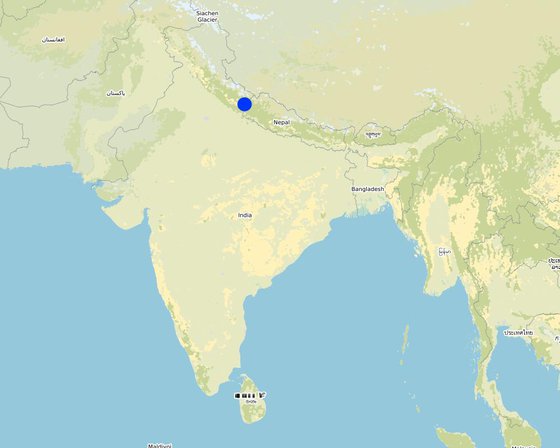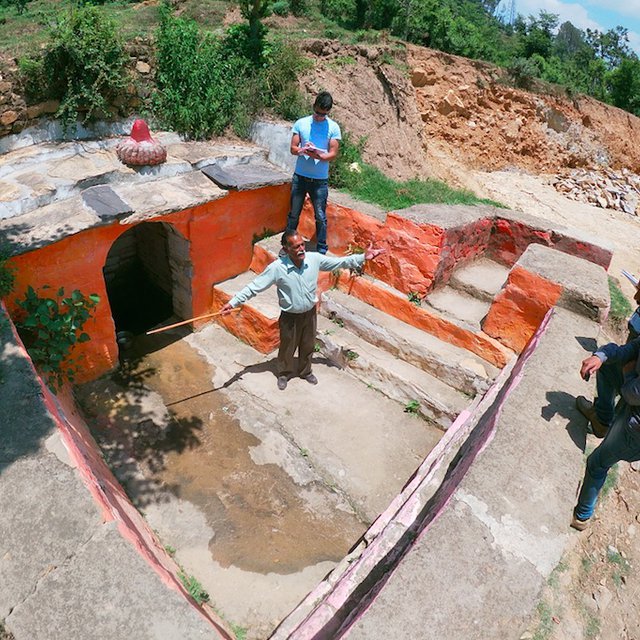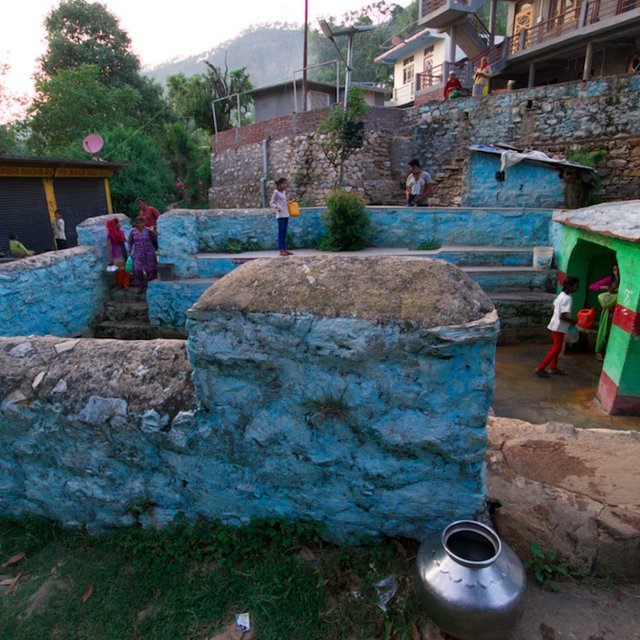



Naulas are imperative sources of natural seepage of drinking water and are considered the most important hydraulic structures to the villages in hill regions of Uttarakhand. They appear as a dry stone masonry structure, normally with a four-sided (rectangle or square) shape with stairs on all the sides and are commonly covered by stone slates and an erected wall on three sides. Since ancient times, water rituals are practiced within the communities and the water from these naulas have idols of various deities like the sun, moon, Earth, Vishnu, Ganesh etc. The main motive of keeping idols of gods and goddesses tied to the naulas is to preserve these structures from pollution and other harmful anthropogenic activities.
The efforts to preserve naulas include; building structural or vegetative barriers on the slope above to prevent physical damage, pollution from runoff and other erosive processes, establishing barriers of entry to deter wildlife and insects, initiating cleaning routines in the villages (scrubbing/disinfecting and clearing debris or weeds around the naulas).
The villages of Nakina, Digtoli, and Bhurmuni have carried out their own traditional measures to conserve these sacred structures and the water that flows into them. Sacred tree species like the peepal and banyan trees have been planted near naulas to signify its sanctity and to protect and shade it. To ensure the potability of a naula's water, biweekly cleaning regimes are undertaken. Structural measures such as check walls, check dams, and water channels have been made above the naulas. Additionally, wildlife entry is inhibited with cloth drapes that cover the naula's entrance, and some villages have established a protective enclosure around the naula.
Routine Naula conservation activities are taken up by those that collect the water, which include mainly the women and children. There is a water queue system in Nakina Village, in which people receive a specific time slot to take the water from the naula. This helps with keeping track of water use and promotes equitable use of water in the village. Other arduous tasks such as constructing the structural technologies include male participation. Monthly or bimonthly community meetings and daily checks on the Naulas help enforce the approach objectives. The villagers are are the sole stakeholders and take up full ownership and water user rights.
Generally, the older community members in these villages stress the need of Naula conservation and management to a greater degree. Members of the younger generation are less concerned and do not exhibit the same level of sensitivity, although they are aware of their importance to the community. The future effectiveness of the approach will depend on village participation and the level of dependency on the Naula for water during the dry season. With the drying of springs and increased use of pipe-schemes (though unreliable), external sources of water may replace this indigenous water harvesting technique.

Location: Digtoli, Pithoragarh Bloc, Uttarakhand, India
Initiation date: n.a.
Year of termination: n.a.
Type of Approach

| What stakeholders / implementing bodies were involved in the Approach? | Specify stakeholders | Describe roles of stakeholders |
| local land users/ local communities | Nakina, Digtoli, and Bhurmuni Village | Local village authorities hold regular meetings with the people to organize, discuss and monitor the use/status of their water resources and naula structures/ |
Decisions were taken by
Decisions were made based on
The World Bank aided Uttarakhand Decentralized Watershed Development Project (GRAMYA) implemented by Watershed Development Directorate of Uttarakhand Government. It is operating since 2005 with the aim to mitigate water problems and addressing issues of other natural resources, with emphasis on women participation. NITI Aayog (National Institution for Transforming India), Government of India has recently launched a National Programme on Regeneration of Springs in the Himalayan Region 2017).
Increased awareness of naula importance; enhanced collaborative water conservation and use within the community
Traditional approaches encompass ecosystem thinking, and therefore good practices such as planting trees above the naula and creating a favorable environment in the catchment area have been adopted by these communities for many generations. Though there has been improvements in infrastructure, officially provided water supply systems have either not reached the remote rural villages or where provided are unreliable, poorly maintained, and not the preferred source of drinking water.
Increased sensitivity to the importance and impact of the surrounding ecosystem to the springs/naula function.
The approach supported community ecosystem-based thinking and has extended to interventions with the Nakina Van Panchayat (community forest council)
Active participation of the community and strong organizational qualities have helped extend their network and resource base
This approach increased engagement and refined attention to their main drinking water resources. Because spring discharge is decreasing, people have started to extend interventions in the microwatersheds or catchment areas of the springs for ground water recharge. This includes establishing plantations, avoiding overgrazing in the forests, and building recharge ponds and trenches.
Increased the combined interest of village-institution cooperation to understand the hydrogeological science behind spring recharge and develop recharge schemes to improve water security.
ICIMOD, G.B. Pant, the Forest Dept., and local NGOS are improving the merging of their efforts when working with particular communities that are open and curious to new projects and scientific technologies.
There is a systematic organization of naula use and care in the villages, which is generally obeyed and thus conflict is avoided.
Upper caste members in the villages continue to determine social inclusion/exclusion with access to water sources. The culture excludes the Dalits in Chuni (lower castes) from accessing or using any Naula in the village except the one that is assigned as theirs. Despite this, the naulas of the lower caste are still considered important for management and conservation.
Improved the realization and need for woman empowerment in decision-making for the water resource use and management. Women in Nakina village feel comfortable to speak up and voice their concerns in group discussions. However, when the water in the naulas reduces, women are still blamed for accessing the spring in an "impure" condition (when menstruating) and are consequently banned from using the naula and sent to live in small huts outside the domains of the main house.
The approach has gained momentum for participation in preservation and restoration of naula structures. If water scarcity persists, the next generation can't expect to make a sustainable livelihood in their home villages.
Increased available water supply for small vegetable patch watering and water for livestock
Decreased risks of pollution from run off, water-born diseases and water availability
Decreased effects and damage of extreme weather events on naula structure (e.g. reduced impact of erosion and pollution from run-off, protection from fire)
The community is and has historically been dependent on these water harvesting structures. What has been implemented through the approach needs to be perpetuated for generation to come, along with management of the forests aand other natural resources within the catchments of the springs.